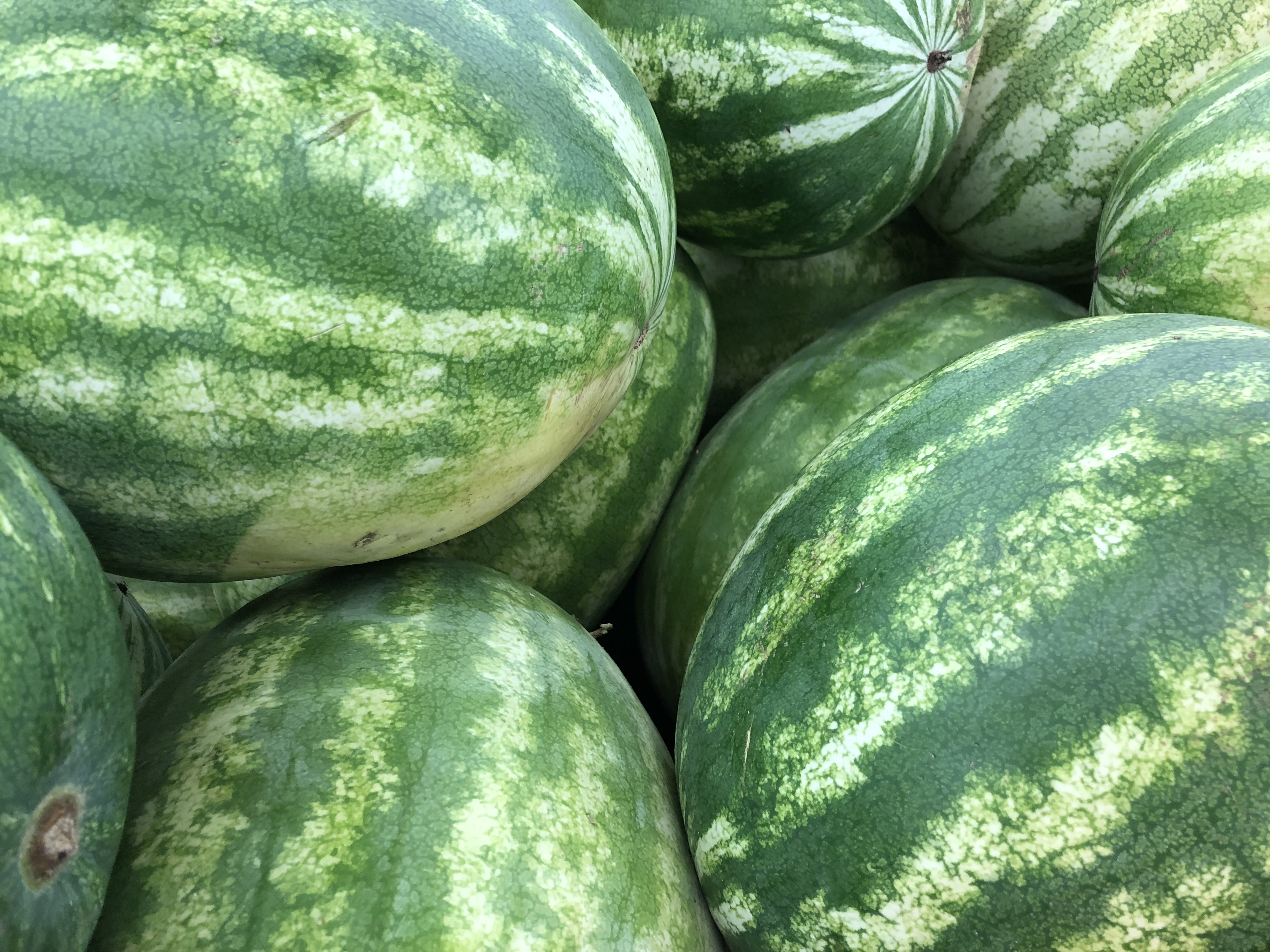
by Melanie Taylor | Jul 8, 2018
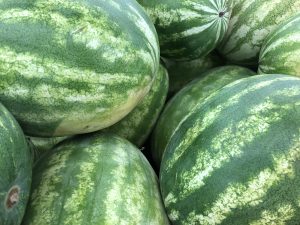
Watermelons are nutritious and help to keep you hydrated.
Photo source: UF/IFAS Northwest District
We tend to think of watermelon as a summer fruit and that is because in Florida, you can find watermelons growing from late spring through mid-summer. “Fresh From Florida” watermelons are available in stores and roadside markets from April through July. Time is running out this summer to have a fresh Florida watermelon, so be sure to get them soon.
Why is watermelon such a popular fruit? One, it is in high abundance during the summer and can be found in most stores. Watermelon also tends to appeal to those with a “sweet tooth,” but it’s still healthy. Red watermelon is a good source of lycopene, which gives watermelon its color (and tomatoes, too). Lycopene is an antioxidant that helps protect the body against heart disease, inflammation, and some cancers.
Watermelon also is a good source of vitamin C and contains vitamin A. Vitamin C is an antioxidant, helping to protect cells from the damage caused by free radicals. Free radicals are compounds formed when our bodies convert the food we eat into energy. People also are exposed to free radicals in the environment from cigarette smoke, air pollution, and ultraviolet light from the sun. The body also needs vitamin C to make collagen, a protein required to help wounds heal. In addition, vitamin C improves the absorption of iron from plant-based foods and helps the immune system work properly to protect the body from disease. Vitamin A is important for normal vision, the immune system, and reproduction. Vitamin A also helps the heart, lungs, kidneys, and other organs work properly.
Probably most impressive is that watermelon is fat free, sodium free and cholesterol free, so we all should feel good about eating it. In addition, as the summer heat continues to increase, we need to drink more water to stay hydrated. Well, watermelon is 92% water, so eating it is an additional way to hydrate. In fact, early explorers used watermelons as canteens.
Here is a technique to know you have chosen a ripe watermelon. Ripe watermelons have a yellow or cream-yellow “ground spot” where the melon rested on the soil. If this spot is green or white, the watermelon probably is not ripe. In addition, once you have selected a ripe melon, a whole watermelon will last in the refrigerator for up to a week.
Before cutting your watermelon, be sure to wipe it with a clean cloth and light, soapy water and then rinse it off. This will prevent you from dragging any bacteria, etc. on the skin through the fruit as you slice it. Once cut, the melon should be kept refrigerated and covered with plastic wrap. If the watermelon flavor is not quite what you expected, you can enhance the flavor by adding a squeeze of lemon juice, honey, or chopped mint.
Be sure to excite your taste buds this summer by biting into a cold, sweet, juicy slice of watermelon. Feel confident in selecting your ripe watermelon and enjoy it, knowing you have made a healthy choice in your food selection.
A Few Fun Facts: (www.freshfromflorida.com/farmtoschool)
- Watermelon seeds are a good source of healthy fats and protein, which help your muscles grow.
- Florida leads the United States in watermelon production.
- Watermelons have been in production since around 2000 BCE.
- Seedless watermelons have been growing in the United States for over 40 years.
- Some countries, like Japan, grow square watermelons.
- Watermelons can have up to a thousand seeds, which can be black or white.
- As it matures, the watermelon’s insides transform from white to red or pink.
- You can eat the crunchy rind and seeds of a watermelon.
- According to John Mariani’s The Dictionary of American Food and Drink, the word “watermelon” first appeared in English dictionaries in 1615.
- Watermelon is the most consumed melon in the United States.
Resources:
Florida Department of Agriculture and Consumer Services
Fresh From Florida
Florida Farm to School
Living Healthy in Florida
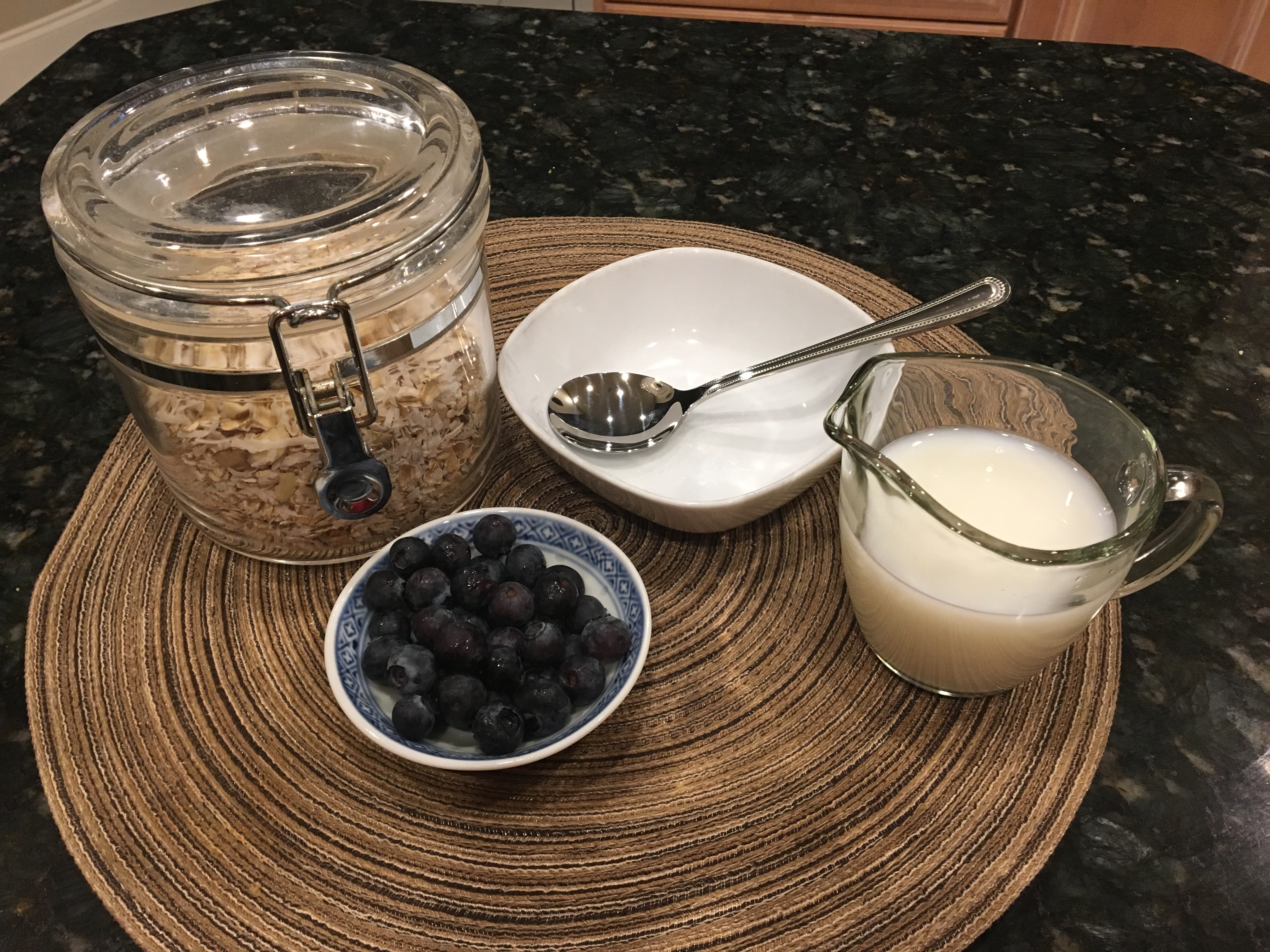
by Pam Allen | Jun 23, 2018
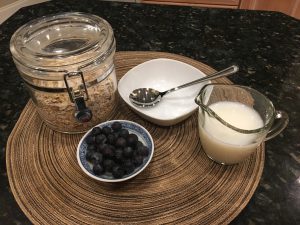
Start Your Day with Whole Grains Photo Source: Pamela Allen
Don’t let the heat of the summer months deter your path to a healthy diet. Stay focused and take small steps that can make a difference in your health. Breakfast is an important part of a healthy diet. Most of us struggle with what to have on hand that is quick, healthy and gets us on track for our daily intake of healthy food. Start your day right by eating whole grains.
The two types of grains are whole and refined. Grain products include bread, pasta, cereals, rice, corn, oatmeal and barley. The United States Department of Agriculture (USDA MyPlate) recommends that people of all ages get half their grain servings from whole grain sources. How do you determine what is whole grain and what is refined? Read the food’s Nutrition Facts label and know the symbol for whole grains. The “Whole Grain Stamp” is a visual symbol placed on the label that identifies foods approved by the Whole Grains Council. Also look at the list of ingredients and if whole grains are listed first, it is a good source of whole grains. Remember that ingredients are listed from most to least so whole grains should be up in the top part of the ingredient list to be beneficial.
Whole grains provide a good source of fiber and B vitamins. Fiber is the carbohydrate that is non digestible. Fiber keeps our digestive system regular and also can help reduce blood cholesterol. A good goal for women is to consume 25 grams each day while men need 38 grams for their daily intake. For specific recommendations visit https://www.choosemyplate.gov/ . Other sources of fiber include fruits and vegetables, seeds, nuts, and beans.
So now back to breakfast, the first meal of the day. Making your own cereal can be healthy and nutritious. Start with a whole gran like oats. This is the base for homemade granola and also can be cooked as a hot cereal. Try this homemade granola recipe to have available for a whole grain option for breakfast.
Homemade Granola
2 cups of old fashioned whole grain oats
½ cup sliced almonds or other nut like pecans or walnuts
½ cup shredded coconut
2 Tablespoons of Maple Syrup or honey
1 Tablespoon of melted coconut oil to coat the oats (can be melted in the microwave for 10 seconds)
¼ teaspoon of vanilla extract
Optional: ½ cup sunflower seeds, ½ cup of dried fruit
Directions
Preheat the oven to 300º F.
Combine all ingredients in a large bowl. Mix well and toss to coat.
Spread the mixture in a thin layer on a baking sheet lined with parchment paper and bake for 10 – 15 minutes, until very lightly toasted. Allow to completely cool before storing.
Granola can be kept in an airtight container in a cool, dry place for up to 2 weeks.
To use as a morning cereal, scoop ¾ cup and cover with Milk. For added flavor and fiber, add fresh fruit like blueberries or strawberries. May also be eaten as a snack or a topping for yogurt sundaes.
For information about upcoming UF IFAS Extension programs in Okaloosa County, visit our website at:
http://sfyl.ifas.ufl.edu/okaloosa email: pha@ufl.edu or call us at 850-689-5850
“An Equal Opportunity Institution”
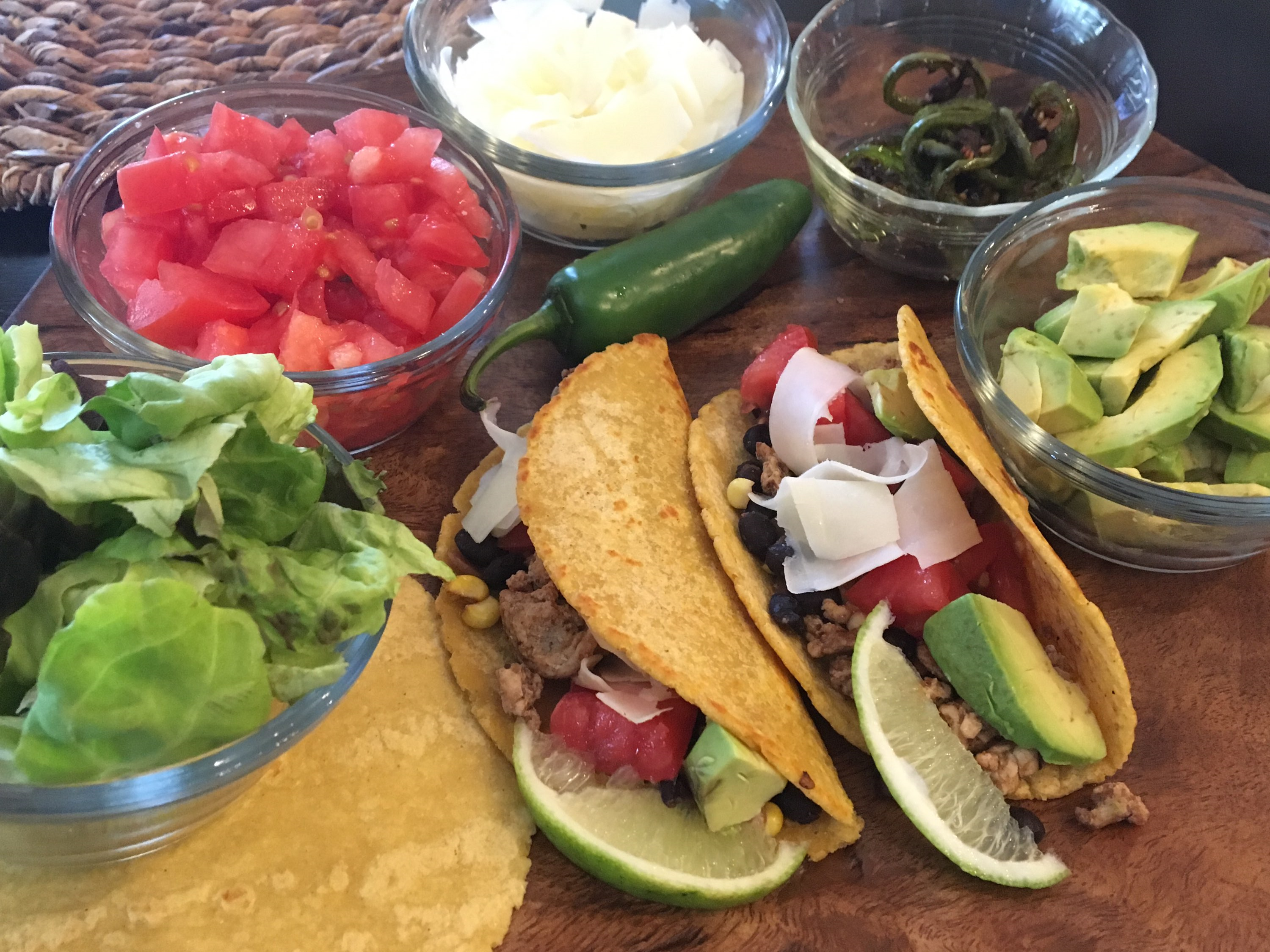
by Pam Allen | Jun 23, 2018
Tacos are a traditional Mexican dish with a mixture of various fillings on a flat bread tortilla. Having recently visited the Yucatan Peninsula and consumed tacos on a daily basis, it became evident that even in Mexico, different regions make their tacos with local available produce, meats, beans and rice. The American version can consist of anything from local produce like zucchini, squash and corn as well as the traditional tomatoes, cheese and lettuce.
Try this taco recipe for a slant on local flavor and taste. My goal is to build a taco that is tasty, local and provides creativity in the ingredients. We will use some of the traditional elements but stick with me as we explore various toppings to make your taco healthy and fresh.
Select your Tortilla
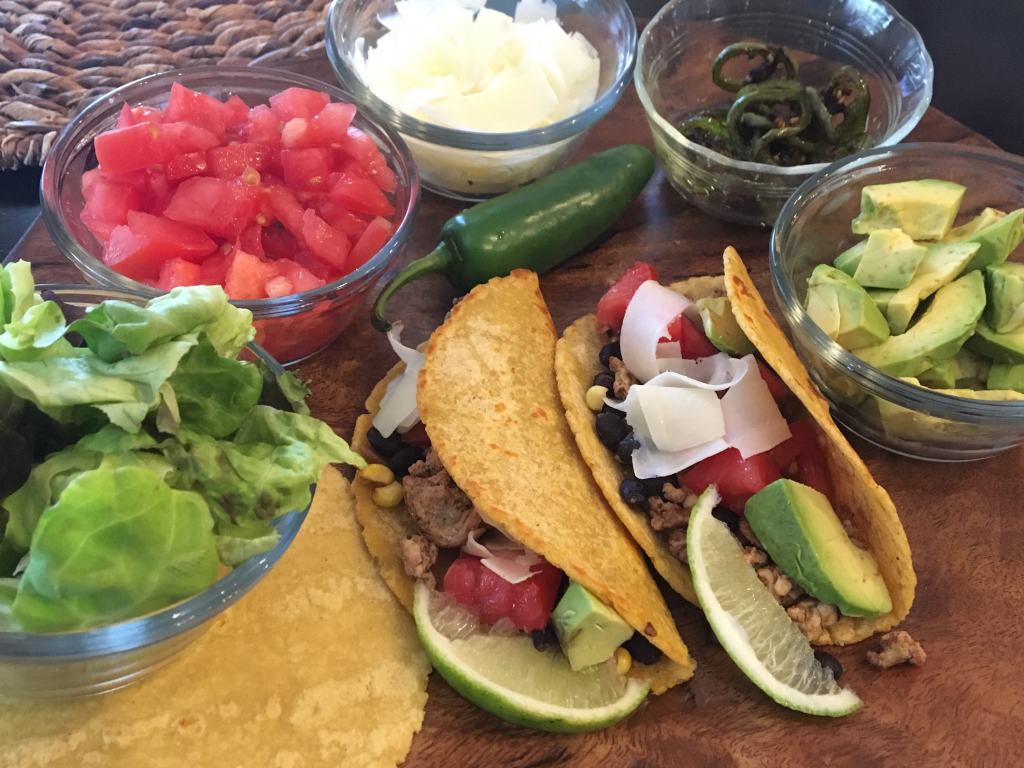
Building a Healthy Taco Using Local Produce. Photo Credit: Pamela Allen
Tortillas are varied in size, color and grain. For a healthy option select the smaller size that are made from whole grains. My favorite is a corn blended tortilla in the six inch circle.
Start with a Protein
The filling can be made from ground turkey, chicken, pork, fish or hamburger. For a vegetarian option try tofu crumbles, black beans or refried vegetarian beans. Brown the meat using your favorite Mexican spice like chili powder, garlic, cumin, white pepper and onion powder.
Pick your Filling
Local vegetables this time of year that will add flavor and color can be used as a filling. Try spiral cut squash using yellow squash or zucchini. Cook in a small amount of olive oil to tenderize. You will want to keep them crunchy so don’t overcook them. Also, shave off fresh corn and add it to your filling or mix it in with your protein.
Pick your toppings
Diced tomatoes make a great topping and add color and flavor. A squeeze of fresh lime juice is also a favorite. Other toppings could include diced avocado or sliced hot peppers like jalapeno, bell or other peppers that grow well in our area. Traditional toppings include various types of shredded cheese and sour cream.
Don’t forget the Fresh Herbs
Cilantro grows very well in this area as well as chives, onions and parsley. Fresh herbs add a splash of color and flavor.
Finishing touches
Try the homemade salsa recipe for a side dish with chips or for a topping to pep up the flavor or your healthy taco.
Fresh Salsa
2-3 medium sized fresh tomatoes (diced into small pieces)
1/2 red onion diced
Peppers of your choice – jalapeno (hot) or bell pepper (milder)
Juice of one lime
1/4 cup chopped cilantro
Salt and pepper to taste
May add some spices like chili powder or cumin for flavor.
Prepare all the ingredients and mix in a bowl. Store in refrigerator for up to 2 days.

by Samantha Kennedy | May 18, 2018

Cow’s milk is an excellent source of calcium, vitamin D, phosphorus, and potassium. (Photo credit: Samantha Kennedy)
There are no bones about it: osteoporosis is no joke. Over time, this condition can lead to brittle bones that break easily and cause debilitating pain. Taking steps early to support bone health can go a long way toward decreasing the risk of developing osteoporosis later.
One excellent way to promote bone strength is through the consumption of calcium and vitamin D. These two nutrients work together to build and strengthen bone tissue. The best way to boost calcium intake is by having a diet filled with calcium-rich foods.
Dairy foods such as milk, cheese, and yogurt are excellent sources of calcium. These foods – but most especially cow’s milk – are also rich in other minerals, such as phosphorus and potassium, as well as two of the B vitamins, B12 and riboflavin.
Phosphorus is important for cell maintenance and repair throughout the body and is especially important for healthy bones and teeth. Potassium is an important electrolyte that helps regulate both water balance and acid-base balance in the blood and tissues.
As for vitamin D, the body produces it naturally through exposure to the sun. Just 10 minutes of sun exposure a day is enough to help the body produce the vitamin D needed to aid in calcium absorption. Foods fortified with vitamin D, such as milk, orange juice, and soy or almond milk, also can provide adequate vitamin D to the body.
One thing to watch out for when choosing dairy foods is the fat content. While these foods are rich in beneficial nutrients, they also can be high in fat. However, there are a wide array of dairy choices that are lower in total fat.
Milk, yogurt, sour cream, and cheese are all available in low-fat or fat free varieties. In fact, fat free (i.e., skim) milk actually contains more calcium per 8 oz. than whole milk! Those unable to consume dairy products due to an allergy or lactose intolerance can still get calcium, vitamin D, and other minerals from products such as soy, almond, coconut, or rice milk which are fortified. (See the infographic, “What’s in your glass?” from the National Dairy Council.)
Dairy foods are part of a healthy and balanced diet. They are rich in a variety of important vitamins and minerals that play a vital role in overall health. For more information about the benefits of dairy or for recipe ideas, please call your local Extension office.
Here is one quick and tasty idea for a cool summer treat: Fruity Yogurt Popsicles!

by Angela Hinkle | May 18, 2018

May is Older Americans Month – Photo credit: Wendy Meredith
“Grandparents Raising Grandchildren” are grandparents who are caregivers for their grandchildren. They have obtained temporary custody or have adopted because the grandchildren’s biological parents often are either incarcerated for crimes related to drugs and/or alcohol addictions or the parents are deceased due to their lifestyles and addictions. The UF/IFAS Escambia County Extension Expanded Food and Nutrition Education Program (EFNEP) has partnered with the Council on Aging in our area to work with these “great” grandparents. EFNEP is a series of nine lessons. We teach parents and grandparents raising grandchildren the knowledge, skills, and behaviors needed to raise healthy families.
What EFNEP Offers Grandparents Raising Grandchildren
Welcome!
Eating Smart Being Active. Tell us your story – we listen to you. We share helpful resources available in the county.
Get Moving!
Let’s Be Active. Learn Physical Fitness with Exercises and Games for the family. Drink Water.
Plan, Shop, and Save!
Plan for nutritious meals and recipes. Shop on a budget and save money.
Fruits and Vegetables Half Your Plate!
Make simple, family-friendly recipes using fruits and vegetables. Use all varieties including what’s in season and grown locally. Learn about important family vitamins, minerals, and dietary fiber.
Make Half Your Grains Whole Grains!
How many grains do I need a day? Why is it important to eat grains?
Go Lean with Protein!
What are animal proteins? What are plant proteins? How much protein do you need each day? What is a lean protein?
Build Strong Bones!
What are sources of low-fat or no-fat dairy? How many servings does your family need each day?
Make a Change!
What are good ways to get rid of too many fats, salts, and sugars from your families’ daily meals and snacks?
Celebrate!
Each EFNEP participant receives a certificate of completion to frame and hang in their home.
Why are Grandparents Raising Grandchildren?
The opioid epidemic is affecting so many families and, really, these folks should be enjoying retirement and their “Older Years.” We are here to supply grandparents who are raising grandchildren with education and tools that equip them to raise healthy and happy children.
EFNEP is here to help

Grandparents Shopping Healthy – Photo credit: Wendy Meredith
EFNEP aids in the challenge with recipes, activities, cooking skills, and researched info. Then we educate about nutritious foods, food safety, physical activity, and how to shop for food on a limited budget. We also provide fresh produce grown, harvested, and donated by the Extension Master Gardeners for in-class recipe tastings. We have, on occasion, taken the grandparents to a local grocery store to “put into action” what they have learned in the EFNEP classes. Each one is given a challenge to purchase a healthy item from each of the five food groups with money that is provided for them.
We also are currently working with Fresh Access Bucks (FAB), which enables us to share with our Grandparents Raising Grandchildren the locations and times of local Farmers Markets and Produce Stands that are FAB partners and accept SNAP and WIC when purchasing Fresh Florida Grown Produce.
Raising children can be hard in our younger adult years. Raising children in our “Older Years” can be extremely challenging, overwhelming, or downright exhausting. Through our partnership, we have been able to help the grandparents by eliminating some of their everyday stresses. We do this by offering them fun, factual, and fresh ideas about nutritious foods and how to prepare yummy, kid-approved snacks and meals. Working with the grandparents has been and continues to be very rewarding. They are always eager to learn and they are committed to the program. And they are so grateful for our involvement. The big smiles on the faces of the Super Grandmas and Super Grandpas say it all!!!

by Angela Hinkle | Apr 27, 2018

Flower, Stems, Root, Leaf Bouquet
Photo credit: Jamie Spiker
Want to show mom how much you really care about her? Try giving her a Mother’s Day flowers, stems, roots, and leaves arrangement. Okay, so these cleverly disguised vegetables are not the usual bouquet. But giving mom a collection of some super healthy vegetables lets her know her health is important to you. And the healthier mom is, the longer you can keep her in your life.
What counts in a Mother’s Day Flowers Stems Roots Leaves arrangement?
- Flowers: Broccoli or Cauliflower
- Stems: Asparagus or Celery
- Roots: Carrots or Radishes
- Leaves: Lettuce or Cabbage Leaves
Why eat vegetables?
Eating vegetables – on Mother’s Day and every day – gives mom and all of us loads of beneficial nutrients. Veggies contain vitamins, minerals, fiber, and water. As part of a regular diet, veggies help reduce heart disease, some cancers, and other chronic diseases. Why else is it important to eat vegetables? See veggie health benefits. And Bonus – most vegetables are low in fat and calories (so they won’t go to mom’s hips).

Happy Healthy Moms with cauliflower, asparagus, carrot, and purple cabbage “bouquets”
Photo credit: Jamie Spiker
How to incorporate more vegetables
So how do you display and celebrate your love for mom with vegetables? Think lots of color. Vegetables come in every color of the rainbow – red, orange, yellow, green, blue, and violet. Because color is so important, try to eat some veggies of every color every week. And adding lots of color makes for a great veggie bouquet – smile-inducing, eye-catching, healthy, and delicious. To add more vegetables to your day, check out USDA’s Tips to vary your veggies. Try veggies grilled, steamed, stir-fried. Then try them kabobbed and in salads. They are fabulous as the main entrée attraction or work great as the side dish.
You say you just can’t bring yourself to give this kind of Mother’s Day Veggie Bouquet? But if you want to incorporate more veggies into mom’s diet and yours, see easy to eat more veggies. And if all else fails, try giving mom some edible flowers. Nasturtiums are bright, colorful, edible flowers with a peppery kick. For more on these flowers, see garden nasturtium.
Mother’s Day flowers, stems, roots, and leaves. These veggies are a colorful, tasty, healthy, and caring way to say, “I love you, Mom!”
HAPPY MOTHER’S DAY!














